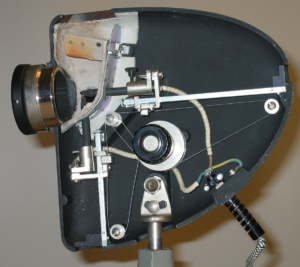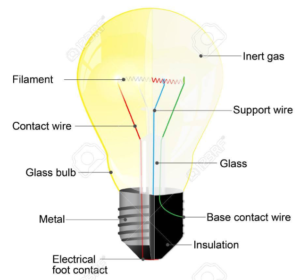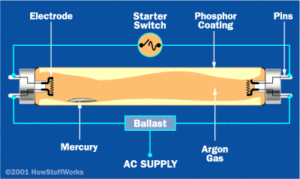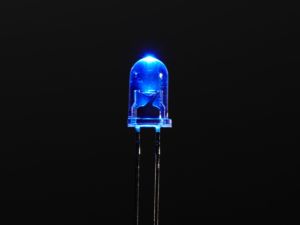Introduction
The invention and utilization of artificial light was crucial to the development of civilization because it enabled humans to extend the length of the day. Today, certain light bulbs are dimmable with a lifetime of over 15,000 hours. However, the light bulb has not always been so efficient and reliable. It has taken the scientific community over 200 years to modernize the light bulb. This article will discuss the evolution of electrical light and the development of the modern light bulb.
The Arc Lamp
The evolution of artificial light began with the invention of the arc lamp in the early 1800’s by a Cornish inventor and chemist named Humphry Davy. The carbon arc lamp was the first commercially successful form of the electric lamp.
Operation: In a carbon arc lamp, the electrodes are carbon rods that exist in free air. To initiate the reaction to ignite the lamp, the rods must be in contact with each other. This allows a relatively low voltage to strike the arc. An arc is an electrical discharge that occurs when a gas is ionized. After the initial contact between the rods, they are slowly drawn apart as an electrical current heats and maintains the arc across the gap. The ends of the carbon rod are heated by this arc and the carbon begins to vaporize. This luminous carbon vapor produces the bright light. Given the characteristics of this reaction, the rods eventually burn out and the distance between them must be adjusted regularly to maintain the arc. Many mechanical devices were invented to regulate the distance between the carbon rods after the initial arc was induced. Most of these inventions were based on solenoids.
Considerations: In the 19th century, the carbon arc lamp was the only electric light with the ability to illuminate large areas. These lamps proved to be cheaper than gas or oil lamps when they were utilized for street lighting. However, carbon rods had to be replaced after a short period of time and replacing them became a full time job in a city. The lamps produce dangerous UV rays and can cause radio frequency interference. Arc lamps were also quite dangerous to use indoors since they could easily cause fires as a result of excessive heat or spark emissions.

Carbon Arc Lamp: This particular model required the distance between the rods to be adjusted manually. Courtesy of Wikipedia.
The Incandescent Bulb
The invention of incandescent lighting can be accredited to numerous scientists dating back to 1761 when Ebenezer Kinnersley, an English born scientist and inventor, demonstrated heating a wire to incandescence. Thomas Edison is often accredited with the commercialization of the incandescent light bulb in the United States since he was able to create a better vacuum pump to fully remove the air from the bulb and develop the Edison screw. The Edison screw is now the standard socket fitting for light bulbs. By October of 1879, Edison and his team had produced an incandescent light bulb with a carbonized filament of cotton thread that could last for about 14.5 hours. As they experimented with different filaments, they discovered that using bamboo guaranteed a lifetime of up to 1,200 hours. This filament thus became the standard for Edison’s bulbs.
Operation: A modern incandescent bulb typically consists of a glass enclosure containing a tungsten filament. Tungsten is used since it has an extremely high melting point. An electric current passes through the filament and heats it to a temperature that produces light. Incandescent light bulbs usually contain a stem or glass mount attached to the bulb’s base. This allows the electrical contacts to run through the envelope without gas leaking out or air leaking in. Small wires embedded in the stem support the filament and its lead wires. The enclosing glass enclosure contains either a vacuum or an inert gas to preserve and protect the filament from evaporating.
Considerations: Unlike the arc lamps discussed before, incandescent bulbs require no external regulating equipment. They have relatively low manufacturing costs and work equally well with alternating current or direct current. As a result, the incandescent bulb became widely used in household and commercial lighting. However, in regards to efficiency, the incandescent bulb definitely has its drawbacks. They convert less than 5% of the energy they use into visible light. The remaining energy is released as heat.

Incandescent Bulb: Diagram displaying the relevant parts of the bulb. Courtesy of 123RF.
The Fluorescent Lamp
In the 1890’s, Thomas Edison and Nikola Tesla experimented with fluorescent lamps but neither inventor was able to commercially produce them. It was not until the early 20th century that Peter Cooper Hewitt, an American born electrical engineer, created a blue-green light by running current through mercury vapor. Hewitt’s lamps proved to be significantly more efficient than incandescent lights. However, they were also impractical due to the color of the light.
In 1974, researchers at Osram Sylvania began investigating ways to adjust the color of the light emitted and minimize the size of the ballast to make the lamp more practical. In 1976, Edward Hammer at General Electric discovered a way to bend the fluorescent tube into a spiral shape, creating the first compact fluorescent light (CFL).
Operation: Similar to the incandescent bulb, florescent lamps involve a sealed glass tube and uses an electrode at either end. The tube contains a small amount of mercury and an inert gas, typically argon, kept under very low pressure. This tube also contains a phosphor powder which is coated along the inside of the glass.
As current flows through the lamp, there is a significant voltage drop across the electrodes. The electrons are then accelerated through the gas from one end of the tube to the other. This process vaporizes the mercury inside of the tube. As electrons and charged atoms move through the tube, they collide with the gaseous mercury atoms. This collisions bumps the electrons in the mercury atoms to higher energy levels. As the electrons return to their ground state, they emit the photons.
Considerations: In regards to efficiency, the compact florescent light (CFL) consumes about 75% less energy and lasts about 10 times longer than the incandescent bulb. However, the flickering that occurs at high frequency can be irritating to humans and cause eye strains or migraines. In addition, fluorescent light is heavily diffused which makes it impractical for focused beams such as headlights or flashlights.

Fluorescent Lamp: Diagram of the fluorescent lamp in operation. Courtesy of HowStuffWorks.
The Light-Emitting Diode (LED)
In 1962, LEDs were used as practical electronic components. These LEDs were only able to emit low-intensity infrared light. The first visible LEDs were also low intensity and limited to red. The first commercial LEDs were commonly used as replacements for incandescent and neon indicator lamps. They were also used in seven-segment displays. Until 1968, visible and infrared LEDs were extremely costly ($200 per unit) and thus had limited practicality. Today, modern LEDs are available across the visible, ultraviolet, and infrared wavelengths, with high-intensity output.
Operation: An LED is a two-lead semiconductor light source. It is simply a p-n junction diode that emits light when activated. A diode, in its most basic form, is an electronic device that allows current to flow in a particular direction while disrupting its flow in the opposite direction. When a threshold voltage (typically between 0.5-0.7 volts is applied ) is applied to the leads, electrons begin to travel through the circuit and recombine with electron holes within the device. This phenomenon releases energy in the form of photons. This effect is called electroluminescence. The color of the light emitted is entirely dependent on the the energy band gap of the semiconductor. For example, blue light is usually produced using iridium gallium nitride with a direct band gap of ~2.6 eV.
Considerations: LEDs have many advantages over incandescent and florescent light sources. LEDs are extremely energy efficient and have a lifetime of over 20 years. They do not require any external regulating equipment or ballasts. They are also very robust and small which makes them suitable for many diverse applications including aviation lighting, automotive headlamps, advertising, general lighting, traffic signals, camera flashes, lighted wallpaper, plant growing light and medical devices.

Blue LED. Courtesy of AdaFruit.
Conclusion
While significant improvement has been made to artificial light since the early 19th century, advancements have not ceased. The possibility of improving efficiency, reliability, durability, and aesthetics is ever present.
Did you know, FindLight marketplace has numerous incoherent light sources including Integrated LED Modules, High Power LEDs, Lamps and more.
